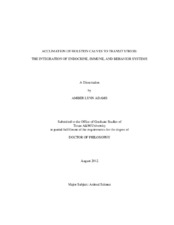| dc.description.abstract | Little is known about the adaptation of livestock to repeated transport. This study determined how repeated transport affected calf feed intake, plasma cortisol (CORT), post-transport behavior, and the expression of immune-related genes. Thirty-six 4-month-old Holstein steer calves were housed in groups of six with each group randomly assigned to either transport (T) or control (C) treatments. The T calves were hauled for 6 h in a 7.3 m x 2.4 m goose-neck trailer, at an average density of 0.87 m2/calf, every 7 d for five consecutive weeks. Individual daily intake was determined using Calan gate feeders. Blood samples were obtained in the trailer or home pen via jugular venipuncture before loading, and after 2, 4, and 6 h of transport. Samples were analyzed for CORT, serotonin, tryptophan, and the gene expression of interleukin-4 (IL-4), interleukin-6 (IL-6), chemokine (C-X-C motif) receptor 2, interleukin-12, toll-like receptor-4, toll-like receptor-2, and 5-hydroxytryptamine receptor 2A in leukocytes. Behavior was recorded for transported calves at 5-min intervals for 1 h after return to their home pens.
The C calves had a higher feed intake than T calves overall (P = 0.01), on the day of transport (P = 0.007), and the day after transport (P = 0.02). Pre-transport CORT concentrations did not differ by treatment (P = 0.77) or trial (P = 0.32). However, the T calves had higher response CORT concentrations than C calves during Transport 3 (P = 0.006), Transport 4 (P = 0.001) and Transport 5 (P = 0.02). The T calves had the highest response CORT concentrations after 2 h of transport and the lowest response CORT concentrations after 6 h of transport (P < 0.0001). Treatment did not affect gene expression in leukocytes, however, the expression of IL-4 (P = 0.01) and IL-6 (P = 0.05) was significantly lower after 2 h of transport than any other sampling times. These results suggest conflicting conclusions on whether the calves started to acclimate after being transported five times. However, CORT and gene expression differences occurred in response to the blood sampling regimen, which may provide insight to how calves acclimate during prolonged stress. | en |


